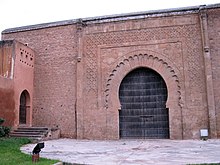|
Bab er-Rouah
Bab er-Rouah (also spelled Bab er-Ruwah or Bab Rouah) is a monumental gate in the Almohad-era ramparts of Rabat, Morocco. HistoryIt was built by the Almohad caliph Ya'qub al-Mansur in the late 12th century, as part of the monumental capital he started building here. The gate and its adjoining ramparts were finished by 1197.[1][2] The Arabic name Bab ar-Ruwah, meaning "Gate of the Winds", likely derives from the strong Atlantic winds which batter the city.[3] The entrance archway of the gate today is smaller than it was originally because it has been partly filled-in with smaller stones.[3] This reduction dates from the time of the Alaouite sultan Sidi Muhammad ibn Abdallah (second half of 18th century), who made similar adjustments to the Bab Agnaou gate in Marrakesh.[1][4]: 480 Today the gate's interior has been converted into an art gallery. It was recently renovated in 2000–2001.[2] Architecture The gate is notable for its defensive structure as well as for its rich stone-carved decoration which is comparable to other monumental Almohad gates such as Bab Oudaia to the north (also in Rabat) and to Bab Agnaou in Marrakesh.[5][6] The gate was built in reddish stone but the constant blow of the seaborne winds has changed much of its colour to a duller grey.[3] The gate's exterior entrance is flanked by two bastion towers. The archway of the entrance was partially filled-in with a smaller arch under the Alaouite sultan Muhammad ibn Abdallah in the second half of the 18th century.[1] The decoration of the gate's outer façade includes three concentric semi-circles carved with polylobed and radiating motifs, which are in turn framed inside a rectangular alfiz. The two ends of the innermost semi-circle, at the spring of the arch, are carved into "S"-like serpentine forms which are also seen at Bab Oudaia but very rarely elsewhere.[3][5] The spandrels between in the corners within this alfiz are carved with arabesque vegetal motifs in at the center of which is a carved seashell. The frame of the alfiz itself contains an Arabic inscription in Kufic script featuring a Qur'anic verse, translated as the following:[3]
The gate's interior passage passes through four chambers and turns 90 degrees four times, constituting a complex bent entrance typical of Almohad military architecture.[7][3] One of the chambers was originally open from above (but is sheltered by a roof today) so that the defenders could throw projectiles onto any attackers entering the gate.[3] The inner façade of the gate, facing towards the city, is more simply decorated with a single polylobed semi-circle carved around the horseshoe archway, which is framed by a wide band filled with a sebka pattern. ReferencesWikimedia Commons has media related to Bab Rouah.
|
||||||||||||||||

